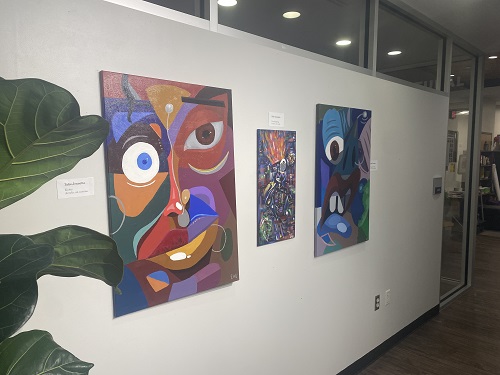
Zeke Jennette, a pre-vet student minoring in art from Durham, NC, aims to use his art as a way to help with the under-representation of Black Americans and people of color in art. His works tend to be abstract or realistic portraits.
He was featured in ICA’s Students of Color art exhibit during Black History Month and recently had a piece called “Hues of Disaggregation” (pictured above) in Bardo Arts Center in the spring 2022 semester.
Jennette is looking to go to vet school next year.
He has always been drawn to art, in part because it offers a different, more free-flowing way of interpreting things than the often black-or-white interpretation of sciences he is used to as a biology major.
Jennette also holds leadership roles on campus, including president of Omega Psi Phi Fraternity Inc. and president of the Pre-Vet Club at WCU.
While balancing school and his leadership roles, it can get difficult to find the time to paint, which is part of the reason he got an art minor – it would require him to exercise creativity and further his skills. Some days he doesn’t feel like painting and some days he has to force himself to paint, but “more often than not, I find little breaks at the beginning or end of a day to get some painting in, even if it is only for 30 minutes,” Jennette said in an email.
Jennette has been passionate about art since he was younger.
“I’ve always drawn. I’ve always, you know, sketched and doodled for as long as I can remember. People say since I was… four or five years old,” he told The WCJ in an interview.
Jennette believes art is usually more freely interpreted, and it unites people and it serves as a way to escape daily life.
“I like art because it can be interpreted a lot of ways and it’s more free-flowing. It’s really a stress reliever for me to just go in my room and paint whenever I have time. I feel like art, you know, unites people,” he said. “I feel like it always has… since… the beginning of time with cave paintings and everything.”
Jennette feels that we need more art in the world since art reflects the world. That’s why he tries to paint more darker-skin tones “that aren’t usually represented in museums and galleries.”

Growing up, Jennette would go to galleries and museums, but would not see many pieces depicting people who looked like him. A lot of art tends to reflect more fair-skinned people, like Caucasians and European Americans. He thinks that art is becoming more representative of all people, but he also wants to be part of that change by portraying people of color, such as in his piece “Oshun.”
“I try to paint darker skin tones that aren’t usually represented in museums and galleries. I feel like that’s important. Growing up… I wouldn’t really see people that looked like me in the characters of the paintings. That’s definitely improving a lot nowadays. I kind of want to be a part of that as well,” Jenette summarized. Painting darker skin tones have been an important life experience in terms of expressing himself.

In high school, he attended an early college where he took an introductory painting class, where painting became his favorite form of art. He said he’s more drawn to painting acrylic portraits and abstracts instead of landscapes. Abstracts allow that freedom while painting, but he prefers realistic portraits. Jennette still sketches, but it’s more for the purpose of planning his paintings out.
Jennette also said that it’s important to “expose yourself to a lot of… experiences in life…” in order to help inspire creativity and broaden the lenses through which you view the world. He tries to listen to a lot of genres of music because he feels that “it opens your brain up a little more,” allowing for more opportunities for influence. He tries to go to museums, go to bars if a band is playing, go to gardens and nature, play instruments and do anything to broaden his horizons.
The quality of his work matters more to him than the quantity of his portfolio, which is why he feels he doesn’t have a large collection compared to other artists. He also believes in the importance of supporting smaller, local artists. Their quality can be just as good as big-name artists, but they’re usually cheaper. Local art also has the added benefit of supporting “starving artists.”

“There are a lot of quality local artists that have the same skillset as famous artists… There are a lot of artworks that I think are terrible but they sell for like $6 million… You can buy a quality painting for a couple of hundred dollars from a local artist.” Jennette also said there are a lot of artists who don’t have much money, so buying from them definitely helps support them.
On the note of future projects and art business plans for Jennette, he has a website coming May 1 called JennetteFineArts.com where he will be posting and selling his works. He is also working on a piece called “Adoration of Balthazar”, which he said is his favorite piece yet. He will post it on his Instagram, @high_v0ltage_, on April 12.






